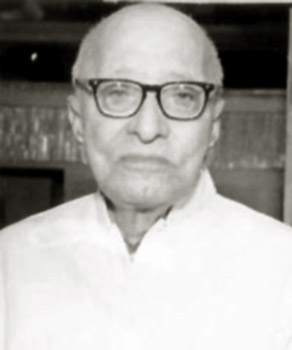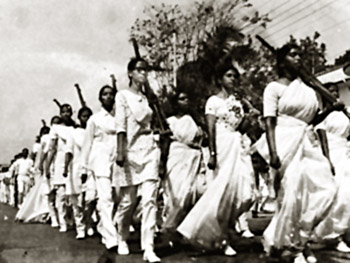 Women during Civil Disobedience Movement in Chennai participated quite enthusiastically even though their political demonstrations were less dramatic than those in either Mumbai or Bengal. Women picketed and marched in processions but it was always difficult to mobilize large numbers of women for action. Even though there was seen support given to the Swadeshi pledge for spinning, wearing, and selling khaddar, generally the women of Chennai did not join the revolutionary movement much and nor were they the subjects of extreme police violence.
Women during Civil Disobedience Movement in Chennai participated quite enthusiastically even though their political demonstrations were less dramatic than those in either Mumbai or Bengal. Women picketed and marched in processions but it was always difficult to mobilize large numbers of women for action. Even though there was seen support given to the Swadeshi pledge for spinning, wearing, and selling khaddar, generally the women of Chennai did not join the revolutionary movement much and nor were they the subjects of extreme police violence.
The reason for the low participation of women lies in the nature of the politics of Chennai as well as the tactics of the nationalist movement in this province. First, there had been considerable debate within the Madras Congress as to whether or not to accept Mahatma Gandhi`s leadership. There were many leaders who did not support his plan. Second, Congress was seen as a party of the Brahmin elite. Third, in other parts of the country women were especially successful in enforcing the boycott of foreign-made cloth. In Chennai, Chakravarti Rajagopalachari, a leading member of Congress, was more concerned with prohibition than with foreign cloth. Secretary of the Prohibition League of India and member in charge of the anti-drink campaign of the Indian National Congress, he regarded this as an issue that went beyond caste and community and had the potential to unite people in a struggle against the government. Unfortunately, picketing liquor shops was one of the most dangerous forms of protest in Chennai and deemed inappropriate for women.
S. Ambujammal was the only daughter of S. Srinivasa Iyengar, a brilliant lawyer and Congress leader. She had heard a lot about and been greatly influenced by Mahatma Gandhi. She joined the Non Cooperation Movement in 1920, began to wear khaddar and spin. Her real entry into the nationalist movement came in 1928 when she decided to form the Women`s Swadeshi League. Members of the League took the Swadeshi vow, spun a certain amount of thread each month, and spread the word about the value or homespun cloth.
 Ambujammal became president of this organization with Mrs. Jamammal as treasurer. Krishnabai Rau organized the Desh Sevikas (Women Serving the Country), women willing to picket, and Indirabai Rau (Krishnabai s sister) took over propaganda. In the beginning this organization consisted of the officers and a few other women who met daily to spin and discuss the progress of the protest movement. When the call came to women to join the movement they went door to door preaching the value of Swadeshi, organized Swadeshi exhibitions, sold khaddar in the streets, and joined men in picketing. Women especially enjoyed joining Prabhat Pheries or morning walks when they sang freedom songs. In the early morning hours women, sometimes numbering in the hundreds, would walk through the streets singing songs of Swadeshi and Swaraj.
Ambujammal became president of this organization with Mrs. Jamammal as treasurer. Krishnabai Rau organized the Desh Sevikas (Women Serving the Country), women willing to picket, and Indirabai Rau (Krishnabai s sister) took over propaganda. In the beginning this organization consisted of the officers and a few other women who met daily to spin and discuss the progress of the protest movement. When the call came to women to join the movement they went door to door preaching the value of Swadeshi, organized Swadeshi exhibitions, sold khaddar in the streets, and joined men in picketing. Women especially enjoyed joining Prabhat Pheries or morning walks when they sang freedom songs. In the early morning hours women, sometimes numbering in the hundreds, would walk through the streets singing songs of Swadeshi and Swaraj.
Krishnabai Rau, a loyal Gandhian since childhood, responded to Gandhi`s call for civil disobedience by resigning her position as lecturer in Crosthwaite Girls` College, Allahabad, and returning to Chennai. Well known for her leadership skills and ability to speak publicly (as a student Krishnabai had organized the Madras Youth League and given evidence before the Joshi Commission), she organized the Desh Sevika Sangha under the guidance of the Swadeshi League. Dressed in orange saris and blouses, DSS women picketed foreign cloth shops with men volunteers.
When the police first moved against the demonstrators, they attacked the men but not the women. This only strengthened women`s resolve to join the movement against the British. It was not long before the police began to treat women protesters the same as men. Chennai women were among the first arrested in the country. Rukmani Lakshmipathy, accompanying C. Rajagopalachari in his march to Vedaranyam to break the salt laws in 1931, was arrested and became the first female political prisoner in Vellore women`s jail.
At a meeting held to protest the brutal treatment of the Satyagrahis, 5,000 mill-hands began to stone the watching police. The police retaliated by lathi-charging the group, killing three people and wounding five. This event frightened both congress leaders and women Satyagrahis neither of whom wished to incite mob violence or provoke police retaliation. It had the effect of dampening the enthusiasm of women for mass demonstrations.
Thus, though the participation of the Chennai women in the Civil Disobedience Movement was more restricted than in other parts of the country their limited participation too showed the enthusiasm of women to participate in the nationalist struggle.



















